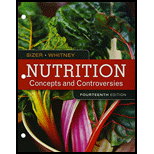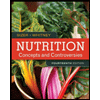
Bundle: Nutrition: Concepts and Controversies, Loose-leaf Version, 14th + MindTap Nutrition, 1 term (6 months) Printed Access Card
14th Edition
ISBN: 9781337127523
Author: Frances Sizer, Ellie Whitney
Publisher: Cengage Learning
expand_more
expand_more
format_list_bulleted
Question
Chapter 11, Problem 14SC
Summary Introduction
To determine:
Whether the statement ‘For the great majority of cancers, lifestyle factors and environmental exposures are the major risk factors’ is true or false.
Introduction:
Cancer is a condition that occurs due to the abnormal and uncontrolled division of cells in the body. In most cases of cancer, the exact source of cancer is not known. The causes of cancer may include genetic influences, lifestyle choices, microbial infections, and environmental exposures.
Expert Solution & Answer
Want to see the full answer?
Check out a sample textbook solution
Chapter 11 Solutions
Bundle: Nutrition: Concepts and Controversies, Loose-leaf Version, 14th + MindTap Nutrition, 1 term (6 months) Printed Access Card
Ch. 11 - Complementary and alternative medicines (CAM)...Ch. 11 - Prob. 2RQCh. 11 - Prob. 3RQCh. 11 - Prob. 1CTCh. 11 - Prob. 2CTCh. 11 - Prob. 1SCCh. 11 - Prob. 2SCCh. 11 - A healthy digestive system defends against...Ch. 11 - Prob. 4SCCh. 11 - Prob. 5SC
Ch. 11 - Prob. 6SCCh. 11 - Prob. 7SCCh. 11 - Prob. 8SCCh. 11 - Men suffer more often from heart attacks than...Ch. 11 - Smoking powerfully raises the risk for CVD in men...Ch. 11 - Which of the following minerals may help to...Ch. 11 - Prob. 12SCCh. 11 - Prob. 13SCCh. 11 - Prob. 14SCCh. 11 - Prob. 15SCCh. 11 - Prob. 16SCCh. 11 - Prob. 17SCCh. 11 - Prob. 18SCCh. 11 - Prob. 19SCCh. 11 - Prob. 20SC
Knowledge Booster
Learn more about
Need a deep-dive on the concept behind this application? Look no further. Learn more about this topic, health-nutrition and related others by exploring similar questions and additional content below.Similar questions
- Individuals can slow the rate of aging by modifying all of these lifestyle aspects except for ________. diet exercise genetic factors stressarrow_forwardDistinguish between genetic screening programs for newborns and adults, and discuss the scope and implications of genetic counseling.arrow_forwardThe following family has a history of inherited breast cancer. Betty (grandmother) does not carry the gene. Don, her husband, does. Dons mother and sister had breast cancer. One of Betty and Dons daughters (Sarah) has breast cancer; the other (Karen) does not. Sarahs daughters are in their 30s. Dawn, 33, has breast cancer; Debbie, 31, does not. Debbie is wondering if she will get the disease because she looks like her mother. Dawn is wondering if her 2-year-old daughter (Nicole) will get the disease. a. Draw a pedigree indicating affected individuals and identify all individuals. b. What is the most likely mode of inheritance of this trait? c. What are Dons genotype and phenotype? d. What is the genotype of the unaffected women (Betty and Karen)? e. A genetic marker has been found that maps very close to the gene. Given the following marker data for chromosomes 4 and 17, which chromosome does this gene map to? f. Using the same genetic marker, Debbie and Nicole were tested. The results are shown in the following figure. Based on their genotypes, is either of them at increased risk for breast cancer?arrow_forward
- The most common therapeutic approaches to treating cancer include all of the following except ________. a. chemotherapy b. irradiation of tumors c. surgery to remove cancerous tissue d. administering doses of vitaminsarrow_forwardShould he reconsider and try chemotherapy instead? Bruce and his parents moved to a semi-tropical region of the United States when he was about 3 years old. He loved to be outside year-round and swim, surf, snorkel, and play baseball. Bruce was fair-skinned, and in his childhood years, was sunburned quite often. In his teen years, he began using sunscreens, and although he never tanned very much, he did not have the painful sunburns of his younger years. After graduation from the local community college, Bruce wanted an outdoor job and was hired at a dive shop. He took people out to one of the local reefs to snorkel and scuba dive. He didnt give a second thought to sun exposure because he used sunscreen. His employer did not provide health insurance, so Bruce did not go for annual checkups, and tried to stay in good health. In his late 20s, Bruce was injured trying to keep a tourist from getting caught between the dive boat and the dock. He went to an internist, who treated his injury and told Bruce he was going to give him a complete physical exam. During the exam, the internist noticed a discolored patch of skin on Bruces back. She told him that she suspected Bruce had skin cancer and referred him to a dermatologist, who biopsied the patch. At a follow-up visit, Bruce was told that he had melanoma, a deadly form of skin cancer. Further testing revealed that the melanoma had spread to his liver and his lungs. The dermatologist explained that treatment options at this stage are limited. The drugs available for chemotherapy have only temporary effects, and surgery is not effective for melanoma at this stage. The dermatologist recommended that Bruce consider entering a clinical trial that was testing a DNA vaccine for melanoma treatment. These vaccines deliver DNA encoding a gene expressed by the cancer cells to the immune system. This primes the immune system to respond by producing large quantities of antibodies that destroy melanoma cells wherever they occur in the body. A clinical trial using one such DNA vaccine was being conducted at a nearby medical center, and Bruce decided to participate. At the study clinic, Bruce learned that he would be in a Phase Ill trial, comparing the DNA vaccine against the standard treatment, which is chemotherapy, and that he would be randomly assigned to receive either the DNA vaccine or the chemotherapy. He was disappointed to learn this. He thought he would be receiving the DNA vaccine.arrow_forwardIf your father were diagnosed with an inherited disease that develops around the age of 50, would you want to be tested to find out whether you would develop this disease? If so, when would you want to be tested? As a teenager or sometime in your 40s? If not, would you have children?arrow_forward
- What is a biomarker? the color coding of different genes a protein that is uniquely produced in a diseased state a molecule in the genome or proteome a marker that is genetically inheritedarrow_forwardWhich of the following imaging studies can be used most safely during pregnancy? CT scans PET scans ultrasounds X-raysarrow_forward
arrow_back_ios
arrow_forward_ios
Recommended textbooks for you
 Nutrition: Concepts and Controversies - Standalo...Health & NutritionISBN:9781305627994Author:Frances Sizer, Ellie WhitneyPublisher:Brooks ColeLifetime Physical Fitness & WellnessHealth & NutritionISBN:9781337677509Author:HOEGERPublisher:Cengage
Nutrition: Concepts and Controversies - Standalo...Health & NutritionISBN:9781305627994Author:Frances Sizer, Ellie WhitneyPublisher:Brooks ColeLifetime Physical Fitness & WellnessHealth & NutritionISBN:9781337677509Author:HOEGERPublisher:Cengage Human Heredity: Principles and Issues (MindTap Co...BiologyISBN:9781305251052Author:Michael CummingsPublisher:Cengage Learning
Human Heredity: Principles and Issues (MindTap Co...BiologyISBN:9781305251052Author:Michael CummingsPublisher:Cengage Learning Human Biology (MindTap Course List)BiologyISBN:9781305112100Author:Cecie Starr, Beverly McMillanPublisher:Cengage Learning
Human Biology (MindTap Course List)BiologyISBN:9781305112100Author:Cecie Starr, Beverly McMillanPublisher:Cengage Learning

Nutrition: Concepts and Controversies - Standalo...
Health & Nutrition
ISBN:9781305627994
Author:Frances Sizer, Ellie Whitney
Publisher:Brooks Cole

Lifetime Physical Fitness & Wellness
Health & Nutrition
ISBN:9781337677509
Author:HOEGER
Publisher:Cengage



Human Heredity: Principles and Issues (MindTap Co...
Biology
ISBN:9781305251052
Author:Michael Cummings
Publisher:Cengage Learning

Human Biology (MindTap Course List)
Biology
ISBN:9781305112100
Author:Cecie Starr, Beverly McMillan
Publisher:Cengage Learning
Cell Differentiation | Genetics | Biology | FuseSchool; Author: FuseSchool - Global Education;https://www.youtube.com/watch?v=gwAz_BtVuLA;License: Standard YouTube License, CC-BY